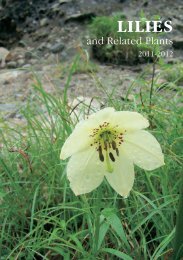LILIES - RHS Lily Group
LILIES - RHS Lily Group
LILIES - RHS Lily Group
You also want an ePaper? Increase the reach of your titles
YUMPU automatically turns print PDFs into web optimized ePapers that Google loves.
Table 2: Perth Long-term Averages<br />
Jan Feb Mar Apr May Jun Jul Aug Sep Oct Nov Dec Annual<br />
Mean Max (ºC) 30.6 31.2 29.3 25.9 22.4 19.2 18.3 18.6 20.0 22.7 26.2 28.7 24.4<br />
Mean Min (ºC) 17.7 17.9 16.5 13.8 10.9 8.8 7.8 8.0 9.4 11.0 14.0 16.2 12.7<br />
Mean Rain (mm) 18.1 5.7 23.5 28.1 98.5 148.4 154.6 135.9 89.6 45.6 21.0 5.2 779.3<br />
Mean Rain (days) 2.0 2.1 4.8 6.5 12.4 16.7 17.7 16.2 14.9 9.6 5.9 3.8 113.6<br />
Based on data from the Australian Bureau of Meteorology<br />
how to do things through the school of ‘hard knocks’. Growing lilies in South<br />
Western Australia has provided us with a number of specific challenges, very<br />
different to any other place in the world. To start with, the land is very sandy<br />
with a low nature soil PH of 4.5. Being sand it is quick to leach and growing<br />
conditions can be difficult with strong cold winds from the Antarctic during the<br />
August and September period. On the other hand, our summers are much milder<br />
than those experienced in Perth, often described as Mediterranean (see tables<br />
1 & 2) and we live and work in one of the most beautiful parts of Australia, the<br />
value of which can never be underestimated.<br />
The previous owners, although putting in some sound infrastructure, grew mainly<br />
during the natural season and even then, not in huge numbers. Even now we<br />
cannot be viewed as a big grower, cropping just over 300,000 lilies a year. To<br />
meet year round challenge we are reworking our 4000 m 2 of plastic tunnels into<br />
a hot house. The wonder of growing here is that by removing the wind chill<br />
and retaining warmth during the day, there is no need to have any other heating<br />
system other than that provided to us by Mother Nature.<br />
To resolve the low soil pH (a good level should be around 6), we have used<br />
lime and regularly add peat and well-composted materials. This has helped<br />
increase the pH around 5.8 and our asiatic and LA hybrids do very well. Our<br />
orientals are not quite as tolerant of even small drops in pH and we now plant<br />
these in plastic crates with potting mix (although this is expensive and reduces<br />
our profit margin by around 10% per bunch).<br />
As we refuse to use chemicals to fumigate the soil (this is still allowed in<br />
Australia), we grow field peas in rows that lie fallow. This helps clean the soil,<br />
give it a nitrogen boost and gives the soil bulk when rotary hoed into the row.<br />
93




